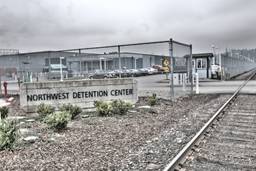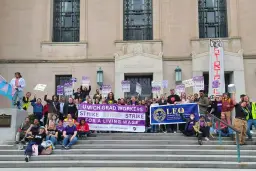Almost one year ago, on May 24, workers at the Rio Tinto borate mine in Boron, Calif., returned to work after being locked-out for 107 days by the British-Australian multinational company with a shady past.
How the workers of International Longshore and Warehouse Union (ILWU) Local 30 started working again is a story of unity, strength and inspiration. In her new film, Locked Out, filmmaker and producer Joan Sekler documents this historic labor fight in the windy high desert.
She takes us to Boron, a small rather isolated town located in the Mojave desert where work is sparse and Rio Tinto is the biggest employer around.
Many of the workers had fathers and grandfathers with a history at the company. Many never thought a company whose parents and grandparents had worked for generations would play hardball while negotiating a new union contract. It was a side of the company they had never known. On Jan. 30, 2010, workers rejected Rio Tinto’s proposed contract, which stripped much of what their union had fought for. Then they fought back.
Sekler has a clear story arc, as her film catches the beginning of negotiations before the lockout, to the end, as a long line of workers in their vehicles head back into work, honking, cheering and yelling.
Sekler’s cameras take us to the Saturday ILWU Local 30 union meeting where membership voted to reject the contract. “All those in favor of rejecting this contract say ay!” We hear unionists thunder in response.
Keeping good on its word to punish workers if they rejected the contract, the company locked them out the next day, Jan. 31, and replaced them with scabs.
“I had never, in my 31 years of employment, never imagined that we would be locked out of our jobs. It was devastating,” one worker, Kim Evans, says in the new film.
Sekler takes us into the lives of the workers who fought back to show miners and their families organizing. We see some approaching local businesses for permission to put up signs in support of the locked out workers. We see them dealing with financial hardships. Some lost their homes and health insurance, even their phone service. Others had to leave their families behind while they sought work in other parts of the country.
ILWU/Local 30 set up financial aid, and a host of committees formed, including a food committee and a financial aid committee. She takes us to “the line,” the gates where the workers remained 24 hours a day to bear witness to who went in and out of the gates and to remind Rio Tinto that they were not going anywhere. We see hired guards shooting video of the workers and buses bringing in scabs. We see children out on the line with their families and mothers pushing baby strollers and grizzled old-timers lending a hand. (See my April 2010 Working In These Times article and photo slideshow, “The Desert Lockout.”
In three months, after Rio Tinto got word that their product wouldn’t be shipped out of the docks because it was scab cargo, they decided to negotiate. ILWU negotiated a contract that put back much of what the company had tried to take out. The workers accepted the contract.
It was a great victory for labor.
Says one worker in Locked Out: “Boron, … we were always the little people. The little team. The little school. We’ve always had to fight. I don’t think they realized what a fighting mentality we have.”
Then there are those who thought unions were passé. Kenny Jackson told the filmmaker:
A lot of us have looked at unions as an organization that may be obsolete, but I’ve got to tell you, when you’re dealing with a worldwide conglomorate like Rio Tinto, you learn to realize that unions aren’t obsolete — and we need them.
Bad track record
Rio Tinto has mining operations all over the globe: Australia, Canada, Namibia, China, U.S., South Africa, Brazil and Colombia,
Cherri Kingsbury Gray started doing some research on the company to find out what Boron workers were up against. “What I found shocked me. We didn’t know this company had such a bad reputation all over the world.”
Rio Tinto’s reputation goes back to the Spanish Civil War. The Rio Tinto company had a penchant for busting unions in Spain. Rio Tinto collaborated with the dictator Franco to use prisoners of war as slave labor in their mines.
Sekler details how Rio Tinto has a notorious history of environmental devastation in communities in Michigan and in Bougainville, Papua New Guinea; and attempting to de-unionize its miners in Australia. It has been a frequent target of criticism over poor policies relating to labor, environmental destruction and labor and human rights.
Clive Porabu, a filmaker, musician and activist, tells Sekler about the history of Rio Tinto on the tribal people in Bougainville and how Rio Tinto forced their way onto the lands of indigenous people and building the mine.
The people mobilized. After army helicopters who received special assistance from Rio Tinto sprayed bullets onto villages from the helicopter, scores of children’s bodies were seen lying along the land. But the indigenous people perservered, and shut down the mine in May 1989. A subsequent blockade lasted nine years and at least 15,000 to 20,000 lives were lost.
Said a tribal member: “We have seen our forests. We have seen our rivers. Beautiful rivers, beautiful trees, beautiful rivers literally turned into dust.”
Vickki John, of the Bougainville Freedom Movement tells Sekler: “it’s disgusting what they’ve done to the environment. [They] don’t seem to have any regret for doing that.”
Back in Boron
Back in Boron, Matt Bachara underscores the importance of the fight: “So many companies are looking to see if Rio Tinto can get away with this, ‘we can get away with this too.’ This is just a microcosm, a little example of what’s going on all across the country,” Bachara told the filmmaker.
Sekler takes us full circle back to the Local 30 meeting where members approve the contract restoring what the company tried to take away.
“They thought they could starve us out. But they didn’t realize that they were dealing with a bunch of desert rats who were a lot tougher than they thought,” Bachara says.
For more information, visit the Locked Out website.







